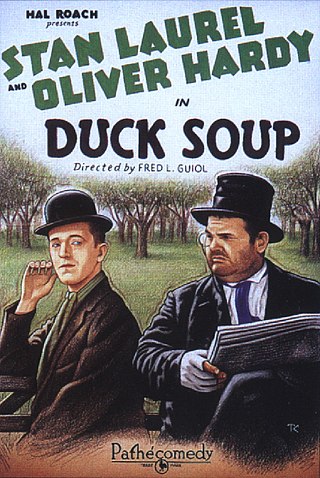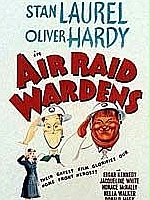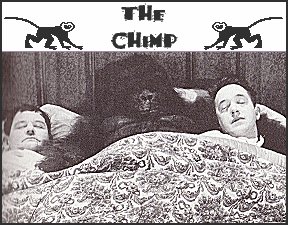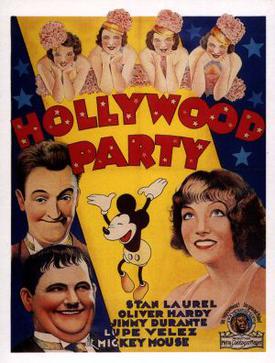
The Hollywood Revue of 1929, or simply The Hollywood Revue, is a 1929 American pre-Code musical comedy film released by Metro-Goldwyn-Mayer. It was the studio's second feature-length musical, and one of their earliest sound films. Produced by Harry Rapf and Irving Thalberg and directed by Charles Reisner, it features nearly all of MGM's stars in a two-hour revue that includes three segments in Technicolor. The masters of ceremonies are Conrad Nagel and Jack Benny.

Laurel and Hardy were a British-American comedy team during the early Classical Hollywood era of American cinema, consisting of Englishman Stan Laurel (1890–1965) and American Oliver Hardy (1892–1957). Starting their career as a duo in the silent film era, they later successfully transitioned to "talkies". From the late 1920s to the mid-1950s, they were internationally famous for their slapstick comedy, with Laurel playing the clumsy, childlike friend to Hardy's pompous bully. Their signature theme song, known as "The Cuckoo Song", "Ku-Ku", or "The Dance of the Cuckoos" was heard over their films' opening credits, and became as emblematic of them as their bowler hats.

The Music Box is a Laurel and Hardy short film comedy released in 1932. It was directed by James Parrott, produced by Hal Roach and distributed by Metro-Goldwyn-Mayer. The film, which depicts the pair attempting to move a piano up a long flight of steps, won the first Academy Award for Best Live Action Short (Comedy) in 1932. In 1997, it was selected for preservation in the National Film Registry by the Library of Congress as being "culturally, historically, or aesthetically significant". The film is widely seen as the most iconic Laurel and Hardy short, with the featured stairs becoming a popular tourist attraction.

Oliver Norvell Hardy was an American comic actor and one half of Laurel and Hardy, the double act that began in the era of silent films and lasted from 1926 to 1957. He appeared with his comedy partner Stan Laurel in 107 short films, feature films, and cameo roles. He was credited with his first film, Outwitting Dad, in 1914. In most of his silent films before joining producer Hal Roach, he was billed on screen as Babe Hardy.

Stan Laurel was an English comic actor, writer and film director who was one half of the comedy duo Laurel and Hardy. He appeared with his comedy partner Oliver Hardy in 107 short films, feature films and cameo roles.

Laurel and Hardy were a motion picture comedy team whose official filmography consists of 106 films released between 1921 and 1951. Together they appeared in 34 silent shorts,A 45 sound shorts, and 27 full-length sound feature films.B In addition to these, Laurel and Hardy appeared in at least 20 foreign-language versions of their films and a promotional film, Galaxy of Stars (1936), produced for European film distributors.

Charlie Hall was an English film actor. He is best known as the "Little Nemesis" of Laurel and Hardy. He performed in nearly 50 films with them, making Hall the most frequent supporting actor in the comedy duo's productions.

Love 'em and Weep is a 1927 American silent comedy short film starring Mae Busch, Stan Laurel and James Finlayson.

Big Business is a 1929 silent Laurel and Hardy comedy short subject directed by James W. Horne and supervised by Leo McCarey from a McCarey (uncredited) and H. M. Walker script. The film, largely about tit-for-tat vandalism between Laurel and Hardy as Christmas tree salesmen and the man who rejects them, was deemed culturally significant and entered into the National Film Registry in 1992.

Duck Soup is a 1927 American silent comedy short film starring Stan Laurel and Oliver Hardy prior to their official billing as the duo Laurel and Hardy. The team appeared in a total of 107 films between 1921 and 1951.

Leave 'Em Laughing is a 1928 two-reel silent film starring Stan Laurel and Oliver Hardy. Produced by the Hal Roach Studios, it was shot in October 1927 and released January 28, 1928 by Metro-Goldwyn-Mayer.

Them Thar Hills is a 1934 American comedy short film directed by Charley Rogers and starring Stan Laurel and Oliver Hardy. The film was so well received by audiences that producer Hal Roach and Metro-Goldwyn-Mayer made a sequel, Tit for Tat, which was released five months later, in January 1935.

Air Raid Wardens is a 1943 comedy film directed by Edward Sedgwick and starring Laurel and Hardy. It was the first of two feature films starring the duo for Metro-Goldwyn-Mayer.

The Bullfighters is the penultimate feature film starring Laurel and Hardy, the sixth and final film the duo made under 20th Century Fox as well as the last released in the United States.

The Chimp is a Laurel and Hardy short film made in 1932. It was directed by James Parrott, produced by Hal Roach, and distributed by Metro-Goldwyn-Mayer. The second half of the film is a reworking from their last silent film Angora Love (1929), itself reworked into a short film the previous year, Laughing Gravy (1931).

Laughing Gravy is a 1931 short film comedy starring Laurel and Hardy. It was directed by James W. Horne, produced by Hal Roach and distributed by Metro-Goldwyn-Mayer.

Their First Mistake is a 1932 American pre-Code comedy short starring Laurel and Hardy. Directed by George Marshall, the film was produced by Hal Roach and distributed by Metro-Goldwyn-Mayer.

The Live Ghost is a 1934 American comedy short film starring Laurel and Hardy, directed by Charles Rogers, and produced by Hal Roach at his studios in Culver City, California.

Hollywood Party, also known under its working title of The Hollywood Revue of 1933 and Star Spangled Banquet, is a 1934 American pre-Code musical film starring Laurel and Hardy, The Three Stooges, Jimmy Durante, Lupe Vélez and Mickey Mouse. It was distributed by Metro-Goldwyn-Mayer. Each sequence featured a different star with a separate scriptwriter and director assigned.

Stan & Ollie is a 2018 biographical comedy-drama film directed by Jon S. Baird. The script, written by Jeff Pope, was inspired by Laurel and Hardy: The British Tours by A.J. Marriot which chronicled the later years of the comedy double act Laurel and Hardy; the film stars Steve Coogan and John C. Reilly as Stan Laurel and Oliver Hardy. The film focuses on details of the comedy duo's personal relationship while relating how they embarked on a gruelling music hall tour of the United Kingdom and Ireland during 1953 and struggled to get another film made.




















